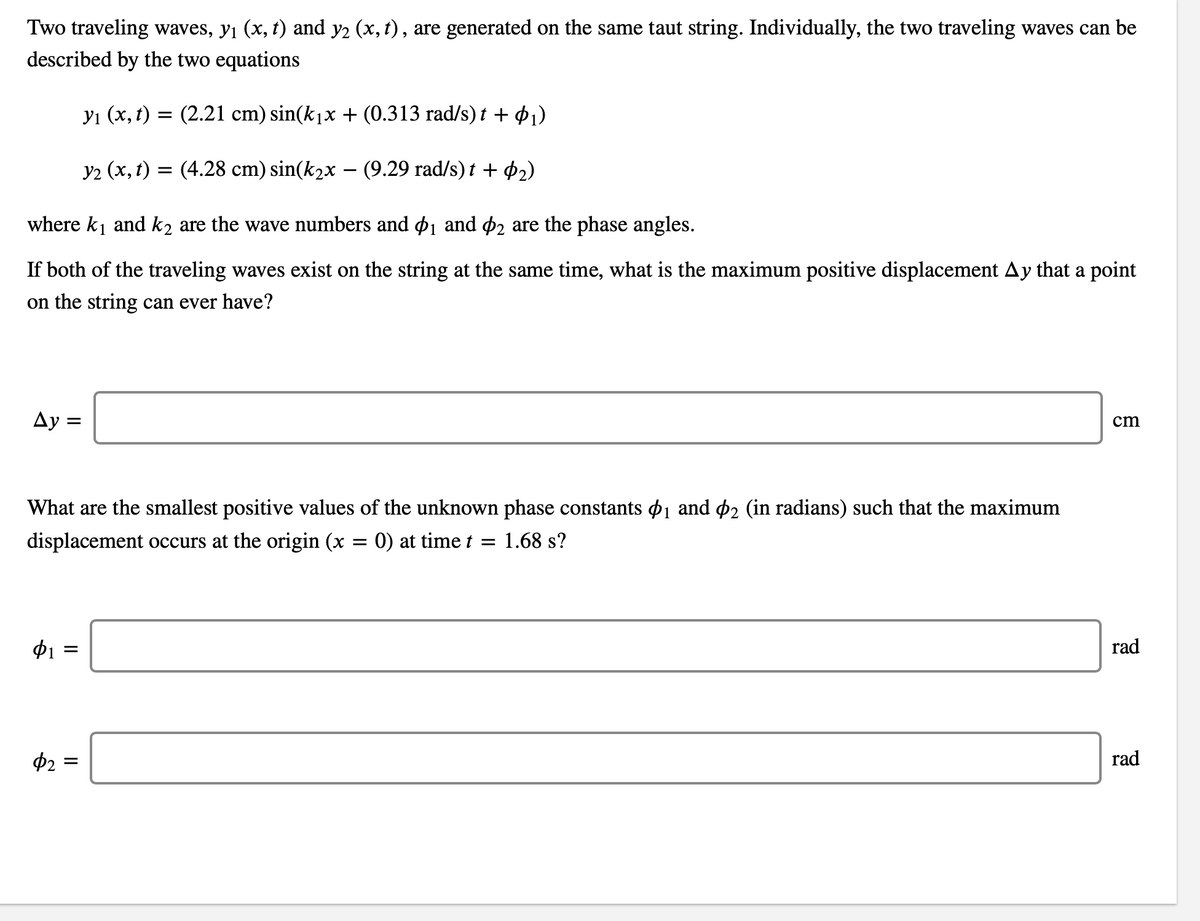Two traveling waves, y1 (x, t) and y2 (x, t), are generated on the same taut string. Individually, the two traveling waves can be described by the two equations yı (x, t) = (2.21 cm) sin(k1x + (0.313 rad/s) t + $1) Уг (х, t) %3D (4.28 сm) sin(k2x — (9.29 rad/s)1 + ф») where k1 and k2 are the wave numbers and ø1 and ø2 are the phase angles. If both of the traveling waves exist on the string at the same time, what is the maximum positive displacement Ay that a point on the string can ever have? Ay = ст What are the smallest positive values of the unknown phase constants o1 and ø2 (in radians) such that the maximum displacement occurs at the origin (x = 0) at time t = 1.68 s? rad $2 = rad
Two traveling waves, y1 (x, t) and y2 (x, t), are generated on the same taut string. Individually, the two traveling waves can be described by the two equations yı (x, t) = (2.21 cm) sin(k1x + (0.313 rad/s) t + $1) Уг (х, t) %3D (4.28 сm) sin(k2x — (9.29 rad/s)1 + ф») where k1 and k2 are the wave numbers and ø1 and ø2 are the phase angles. If both of the traveling waves exist on the string at the same time, what is the maximum positive displacement Ay that a point on the string can ever have? Ay = ст What are the smallest positive values of the unknown phase constants o1 and ø2 (in radians) such that the maximum displacement occurs at the origin (x = 0) at time t = 1.68 s? rad $2 = rad
Physics for Scientists and Engineers: Foundations and Connections
1st Edition
ISBN:9781133939146
Author:Katz, Debora M.
Publisher:Katz, Debora M.
Chapter17: Traveling Waves
Section: Chapter Questions
Problem 12PQ: The equation of a harmonic wave propagating along a stretched string is represented by y(x, t) = 4.0...
Related questions
Question
11) Two traveling waves, ?1(?,?) and ?2(?,?), are generated on the same taut string. Individually, the two traveling waves can be described by the two equations
?1(?,?)=(2.21 cm)sin(?1?+(0.313 rad/s)?+?1)
?2(?,?)=(4.28 cm)sin(?2?−(9.29 rad/s)?+?2)
where ?1 and ?2 are the wave numbers and ?1 and ?2 are the phase angles.
If both of the traveling waves exist on the string at the same time, what is the maximum positive displacement Δ? that a point on the string can ever have?
What is Δ??
What are the smallest positive values of the unknown phase constants ?1 and ?2 (in radians) such that the maximum displacement occurs at the origin (?=0) at time ?=1.68 s?
What is ?1?
What is ?2?

Transcribed Image Text:Two traveling waves, yi (x, t) and y2 (x, t) , are generated on the same taut string. Individually, the two traveling waves can be
described by the two equations
yı (x, t) = (2.21 cm) sin(k1x + (0.313 rad/s) t + ¢1)
y2 (x, t) = (4.28 cm) sin(k2x – (9.29 rad/s) t + $2)
where k1 and k2 are the wave numbers and $1 and ø2 are the phase angles.
If both of the traveling waves exist on the string at the same time, what is the maximum positive displacement Ay that a point
on the string can ever have?
Ду 3
cm
What are the smallest positive values of the unknown phase constants 1 and Þ2 (in radians) such that the maximum
displacement occurs at the origin (x = 0) at time t = 1.68 s?
P1 =
rad
$2 =
rad
II
Expert Solution
This question has been solved!
Explore an expertly crafted, step-by-step solution for a thorough understanding of key concepts.
This is a popular solution!
Trending now
This is a popular solution!
Step by step
Solved in 2 steps

Knowledge Booster
Learn more about
Need a deep-dive on the concept behind this application? Look no further. Learn more about this topic, physics and related others by exploring similar questions and additional content below.Recommended textbooks for you

Physics for Scientists and Engineers: Foundations…
Physics
ISBN:
9781133939146
Author:
Katz, Debora M.
Publisher:
Cengage Learning

University Physics Volume 1
Physics
ISBN:
9781938168277
Author:
William Moebs, Samuel J. Ling, Jeff Sanny
Publisher:
OpenStax - Rice University

Principles of Physics: A Calculus-Based Text
Physics
ISBN:
9781133104261
Author:
Raymond A. Serway, John W. Jewett
Publisher:
Cengage Learning

Physics for Scientists and Engineers: Foundations…
Physics
ISBN:
9781133939146
Author:
Katz, Debora M.
Publisher:
Cengage Learning

University Physics Volume 1
Physics
ISBN:
9781938168277
Author:
William Moebs, Samuel J. Ling, Jeff Sanny
Publisher:
OpenStax - Rice University

Principles of Physics: A Calculus-Based Text
Physics
ISBN:
9781133104261
Author:
Raymond A. Serway, John W. Jewett
Publisher:
Cengage Learning